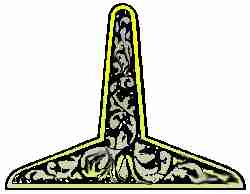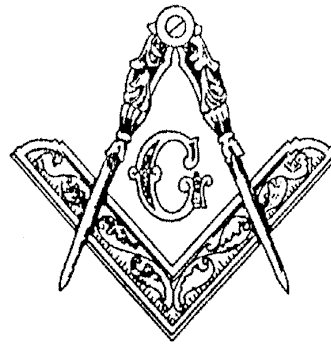The Level is an instrument used by operative Masons to prove horizontals. It is trite to say that it is a symbol of equality. The Declaration of American Independence proclaims that all men are "created equal." With most of us this is a glittering generality, born of the fact that we are all made of the same dust, share a common humanity and walk on the level of time until the grim democracy of death blots out all
 distinctions, and the scepter of the prince and the staff of the beggar are laid side by
side. It is apparent that men are not equal, and cannot be equal either in brain or brawn.
There is no common mold by which humanity can be reduced to a dead level. The world has
various demands requiring different powers; brains to devise great and important
undertakings; seers to dream dreams and behold visions; hands to execute the designs laid
down upon the trestle board; scientists to adorn the mind and reveal the glories of the
universe; poets to inspire the soul and play music on human heart-strings; pioneers to
blaze out the path, and prophets to light up the way to a land where the rainbow never
fades.
distinctions, and the scepter of the prince and the staff of the beggar are laid side by
side. It is apparent that men are not equal, and cannot be equal either in brain or brawn.
There is no common mold by which humanity can be reduced to a dead level. The world has
various demands requiring different powers; brains to devise great and important
undertakings; seers to dream dreams and behold visions; hands to execute the designs laid
down upon the trestle board; scientists to adorn the mind and reveal the glories of the
universe; poets to inspire the soul and play music on human heart-strings; pioneers to
blaze out the path, and prophets to light up the way to a land where the rainbow never
fades. The equality of which the Level is a symbol is one of right and not one of gift and endowment. It stands for the equal right of every man to life, liberty and the pursuit of happiness; the equal right of every man to be free from oppression in the development of his own faculties. It means the destruction of special privilege and arbitrary limitation.
Freemasonry presided over the birth of our Republic and by the skill of its leaders wrote into the organic law of this land the immutable truth of which the Level is a symbol. In a Masonic lodge George Washington was taught that the Level is a symbol of equality. In the darkest hour of the Colonial cause, the soldiers, in a moment of despair and desperation, would have placed on Washington's head the crown of a king. Hayden says, "The overthrow of the rump parliament by Cromwell, the breaking up of the imbecile directory by Napoleon were difficult tasks compared to the ease with which the divided Continental Congress could have been dispersed." Washington was not fighting for royal rank, nor for coronation. As a champion of human rights, he was fighting for exact justice and equality of opportunity, and so the kingship and the crown were rejected with indignation and contempt.
This symbol means that in a Masonic lodge every man should count for one, and no man should count for more than one. In a Masonic lodge the weak and the strong, the rich and the poor, men of diverse creeds and capacity, meet upon the level, close their eyes to arbitrary distinctions and reaffirm that Freemasonry regards no man for his worldly wealth or honors, that the internal and not the external qualifications of a man recommend him to Freemasonry.
Albert Pike said that Freemasonry was the first apostle of equality. The truth of the Level is woven into the fabric of our free institutions. So by Craft and country we are picked and pledged to the practice of this priceless principle.
The square is an instrument used by operative Masons to square their work. In speculative Freemasonry it is a symbol of morality.

It is white with a nameless age. Centuries before the Christian era a negative statement of the Golden Rule was called the principle of acting on the square. Today the expression "upon the square" stands for truthful statement and honest dealing.
In a superficial sense, morality is the verdict of the majority. The elements of time and geography enter into the conception of moral standards. In some aspects morality is relative; what is moral to one man may be immoral to another, what is moral in one position may become immoral when conditions are changed. The word is difficult of definition, but for everyday use, morality seems to be a correct correspondence between conscience, circumstance and conduct. Within definite limits men have a right to prescribe standards of morality for themselves. In the eyes of the law there are two kinds of wrong. One is called "malum in se," that is, an act which is evil in itself and by reason of its inherent nature. The other is "malum prohibitum" that is, an act which is not naturally an evil, but only so in consequence of its being forbidden. Except where fundamentals are involved, it is dangerous for one man to attempt the application of his standards of morality to another man's life.
I remember reading a story of the great flood that came upon the Ohio. In the gray of the morning some men saw a house floating down the river and on its top a human being. Going to the rescue, they found a woman whose life they wished to save, but she said, "No! In this house I have three dead babies, I will not desert; I am going out with them." To most of us that act would verge on the immorality of suicide; to her it was the expression of a mother's love deeper than despair and death; her conduct corresponded with her conscience. We cannot place ourselves in her circumstances and in charity should refrain from judgment.
Jean Valjean was a great hulk of a man, young and strong, ignorant and big hearted, tramping the streets of Paris in search of work, trying to care for a widowed sister and her family of seven little ones. there was no work to be had. He could not bear to hear the voices of starving children so be came home late at night, thinking they would be asleep. But hunger gnawed, and when he came in they were wide-awake and cried, "Oh, Uncle Jean, have you any work? Oh, Uncle Jean, we are so hungry!" Madness seized the man; he went to the nearest bakery, broke the window and stole a loaf of bread. Jean was arrested and sent to Toulon as a galley slave. In the eyes of the law he had committed the immoral act of theft. But his eyes saw pinched-up faces, his ears heard cries of hunger and, regardless of consequences, his conduct corresponded with his conscience in a deed of moral heroism.
Back of all the temporary circumstances and conditions of men and the transitory moral codes evolved by human minds are certain positive standards of morality which the Divine Intelligence has impressed on every particle of matter and every pulsation of energy. They are the same for all mankind, regardless of place, time, race or religion. Of these standards the square is the Masonic mouthpiece. Freemasonry is defined as a beautiful system of morality. It is a woven tapestry of great moral principles and purposes. Whenever a Mason fails to live up to the best that is in him, whenever he blots out the divine light of his conscience, whenever he is recreant to right as God gives him to see the right, he is false to the trying square of his profession, but by this symbol Freemasonry teaches a morality that masters manners, molds mind and makes mighty manhood.
The plumb is an instrument used by operative Masons to try perpendiculars. In speculative Freemasonry it is a symbol of righteousness, that is, an upright life before God and man.
Righteousness is not a sanctimonious word. It means rectitude of conduct, integrity of character, and deathless devotion to truth. The Psalmist asked, "Lord, who shall abide in thy Tabernacle?" and this was the answer: "He that walketh uprightly, and worketh righteousness and speaketh the truth in his heart." When correctly understood, the truth symbolized by the Plumb constitutes a challenge to courage.
In the Sixteenth century Giordazo Bruno taught a plurality of worlds; for this he was accused of heresy. He was tried, convicted and imprisoned in a dungeon for seven years. He was offered his liberty if he would recant, but Bruno refused to stain the sanctity of his soul by denying that which he believed to be true. He was taken from his cell and led to the place of his execution, clad in a robe on which representations of devils had been painted. He was chained to a stake, about his body wood was piled, fagots were lighted and on the spot in Rome where a monument now stands to his memory he was consumed by the flames. Without the hope of heaven or the fear of hell he suffered death for the naked truth that was in him.
The Great Light of Freemasonry contains this promise: "The righteous shall be in everlasting remembrance." Men of tremendous power, men of creative genius, have passed into oblivion, but the righteousness of a pure and noble character, of an unselfish and divinely inspired life finds perpetuation in the clear amber of immortality. Of that righteousness the Plumb is a symbol in Freemasonry.
Unrighteousness has wrought the destruction of peoples and civilizations, but "righteousness exalteth a Nation."
Symbols are not academic playthings, they are intended to provoke and sustain thought.
Fellowcraft Working Tools present to the mind basic ideas of equality, morality and righteousness.
Return to Salem Lodge
THE SHORT TALK BULLETIN
The Masonic Service Association of the United States
VOL. 6 April 1928 NO. 4